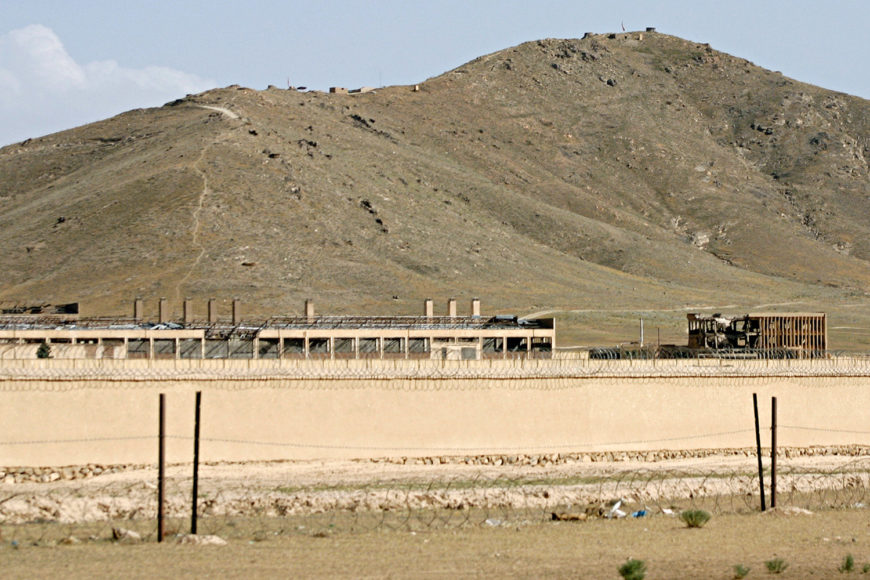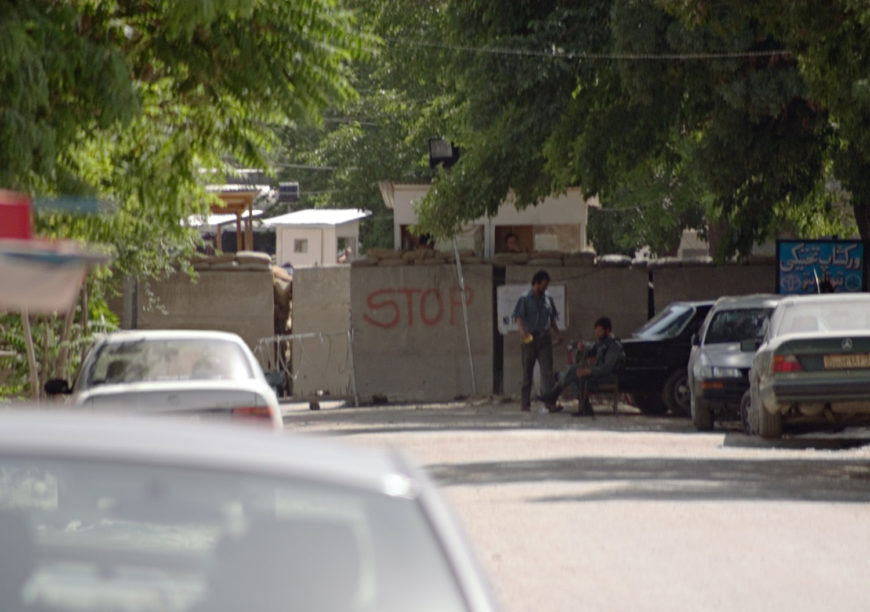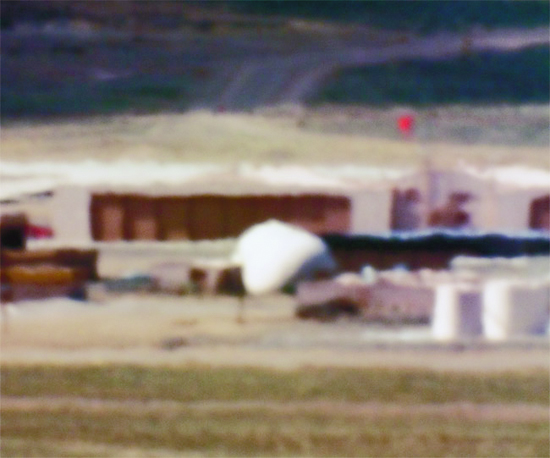As early as August of 2002, the United States Department of Justice drafted a set of legal documents that would come to be known as the “Torture Memos.” [1] The documents advised the Central Intelligence Agency on the use of “enhanced interrogation techniques” on individuals detained by the CIA during the “war on terror.” [2] These techniques included mental and physical abuse, humiliation, deprivation of sleep, food, and water, and were labeled “torture” (a human rights abuse) by Amnesty International in 2003. [3]
The abuse described in these documents is nowhere to be seen in Trevor Paglen’s photograph of The Salt Pit, located outside of Kabul, Afghanistan. Like a companion in the series, Black Site, Kabul, Afghanistan, Paglen’s photograph of The Salt Pit is unassuming. The Salt Pit captures a hillside that might be any number of arid regions worldwide; beneath it, a warehouse that, if we knew no better, might be abandoned. In the foreground, though, barbed wire, and a high, beige wall, partially obstruct our view. As with its companion, Black Site, there is also the slight appearance of pixelation, as if the subject is out of focus, or (as is the actual case), the photograph was taken from a great distance. The banality of the subject matter in each photograph, and the obstructed view they impart, affirm a theme of concealment, indicative of the photographs’ true content: secret CIA prisons, or black sites, facilities used as prisons and interrogation centers, whose existence is denied by their respective governments.
The “enhanced interrogation techniques” counseled in the “Torture Memos” were made visible to the public on April 28, 2004, when 60 Minutes II broadcast photographs taken by a U.S. soldier of the torture of Iraqi prisoners at Abu Ghraib prison near Baghdad. [4] In the week to come, Seymour Hersh’s article, “Torture at Abu Ghraib,” published alongside additional photographs in The New Yorker, would further reveal the graphic and abject character of the CIA’s interrogations. [5] The Abu Ghraib prison photographs became symbols of the coercively inhumane U.S. occupation of Iraq, while indicating a broad and largely invisible infrastructure of interrogation and intelligence gathering at black sites. While it remains unclear what actions took place in the locations he photographed, Trevor Paglen’s Black Sites only further opened our eyes to the U.S. military’s clandestine operations.
Exposing Black Sites
Trevor Paglen has a multi-disciplinary practice that has ranged from making photographs, writing investigative journalism, creating interactive digital exhibits, and, in 2018, launching the first “purely artistic” object into space, the Orbital Reflector. What connects this disparate practice is Paglen’s Ph.D. in Geography. He is interested in mapping, digital technology, and surveillance. In 2006, for example, Paglen published Torture Taxi: On the Trail of the CIA’s Rendition Flights. Part investigative journalism, part photographic survey, Torture Taxi was co-written with the journalist A.C. Thompson and offered, in their words, “a quick glimpse into this new and hidden world” of rendition flights. [6] “Extraordinary rendition” was a policy pursued by the George W. Bush presidential administration that allowed for detaining and transporting enemy combatants from their country of origin to a third-party state, such as to the Guantanamo Bay detention camp (a U.S. Naval base on the island of Cuba). Transportation to the third-party state is referred to as a “rendition flight,” and were made using private, civilian aircraft, in order to conceal their true operators (the US State Department) behind corporate designations. Once transported, combatants were subject to “enhanced interrogation” in an extra-legal situation, outside the U.S. jurisdiction (where torture is illegal). As critics of the program would claim, subjects were abducted for the sake of torture. Paglen’s Torture Taxi was an attempt to document this network of black sites used by the United States. To photograph the black sites, and make them visible to the public, not only implied a desire for truth and substantiation, but also illustrated the extent to which the CIA’s use of torture and “extraordinary rendition” was hidden.
The Salt Pit, revealed
Black Sites – The Salt Pit was taken in Kabul, Afghanistan, from a significant distance, and using an astronomy telescope. The image reveals blurry flat buildings surrounded by security fencing, a desolate landscape, and mountains. No human activity is visible. The site’s code name, The Salt Pit, was revealed in a story in The Washington Post in 2005. However, finding the site’s particular location proved to be a more difficult task. Paglen describes his search here:
To find the Salt Pit, I used a collection of commercial satellite imagery, a compass, testimonies from former prisoners, and a map drawn by a former prisoner. Although they were blindfolded, hooded, and shackled, prisoners held who spent time at the Salt Pit consistently describe a ten-minute ride from the Kabul International Airport to the prison. I also had a map drawn by a man named Khaled el-Masri of what he believed the interior of the prison looked like. If you draw a circle around the Kabul airport that represents the distance that one might travel in ten minutes, and compare that to el-Masri’s map, the Salt Pit jumps out at you. [7]
Paglen’s photograph of the outside of The Salt Pit is neither sharp nor clearly defined. The image’s significance lies not in its aesthetic clarity, but simply in its existence: it is the visible trace of a location where many individuals were illegally detained and subjected to inhumane treatment. The image corroborates allegations as much as el-Masri’s memories.
In photographs such as The Salt Pit and Large Hangars and Fuel Storage, Tonopah Test Range, NV, which was shot from a distance of “about 18 miles,” according to Paglen, the image is the product of careful research into the whereabouts of rendition flights as much as the use of high-power telephotographic lenses, with between 1,300-7,000 millimeter focal lengths. [8] The lack of detail, and subtle blur across the image, are evidence of Paglen’s intent to make “hidden aspects of the landscape become apparent,” while the image’s lack of focus also testifies to the U.S. government’s efforts to conceal their existence from the public. [9]
Susan Sontag
In her landmark 2004 essay, “Regarding the Torture of Others,” Susan Sontag addressed the gravity of the Abu Ghraib photographs and their revelation of U.S. war crimes while speaking to their significance within visual culture: “What is illustrated by these photographs is as much the culture of shamelessness as the reigning admiration for unapologetic brutality.” [10] Noting the pervasive use of digital photography in contemporary U.S. culture, Sontag reflected on the ways in which photography enables trauma as spectacle. But, she was careful to assert, “they were necessary to get our leaders to acknowledge that they had a problem on their hands.” [11] Paglen’s photographs of the CIA’s black sites speak to an enduring quality of photography as a means of visual testimony.
Notes:
[1] “A Guide to the Memos on Torture,” The New York Times, n.d. Accessed Feb. 26, 2022.
[2] The “Torture Memos” included three documents written by the United States Department of Justice and signed in August 2002, including “Standards of Conduct for Interrogation under 18 U.S.C. sections 2340–2340A” and “Interrogation of al Qaeda.” These two documents were drafted by Assistant Attorney General Jay Bybee.
[3] “Torture,” Amnesty International. Accessed Feb. 26, 2022.
[4] “Abuse of Iraqi POWs by GIs Probed: 60 Minutes Has Exclusive Report on Alleged Mistreatment,” 60 Minutes II (April 28, 2004). Accessed Feb. 26, 2022.
[5] Seymour M. Hersh, “Torture at Abu Ghraib,” The New Yorker (April 30, 2004). Accessed Feb. 26, 2022.
[6] Trevor Paglen and A. C. Thompson, Torture Taxi: On the Trail of the CIA’s Rendition Flights (Hoboken, N.J.: Melville House Publishing, 2006).
[7] Trevor Paglen, “The Black Sites.” Accessed Feb. 26, 2022.
[8] “Limit Telephotography: Gallery, San Francisco,” Limit Telephotography. Accessed Feb. 26, 2022.
[9] Trevor Paglen, “Limit Telephotography.” Accessed Feb. 26, 2022.
[10] Susan Sontag, “Regarding the Torture of Others,” The New York Times Magazine, May 23, 2004, 29. Accessed March 23, 2022.
[11] Sontag, “Regarding the Torture of Others,” p. 42.
Additional resources
Seymour M. Hersh, “Torture at Abu Ghraib,” The New Yorker (April 30, 2004). Accessed Feb. 26, 2022.
Jen Itzenson, “The Experimental Geography of Trevor Paglen,” The Brooklyn Rail (February 2007). Accessed Feb. 26, 2022.
Rebecca Leung, “Abuse of Iraqi POWs by GIs Probed,” 60 Minutes II (April 27, 2004). Accessed Feb. 26, 2022.
Trevor Paglen, Blank Spots on the Map: The Dark Geography of the Pentagon’s Secret World (New York: New American Library, 2014).
Trevor Paglen, “The Black Sites,” Accessed Feb. 26, 2022.
Dana Priest, “CIA holds terror suspects in secret prisons,” The Washington Post (November 2, 2005). A01.
Rebecca Solnit, “The Visibility Wars,” Introduction to Trevor Paglen, Invisible: Covert Operations and Classified Landscapes (New York: Aperture, 2010), pp. 6–15.
Susan Sontag, “Regarding the Torture of Others,” The New York Times Magazine (May 23, 2004). Accessed Feb. 26, 2022.




